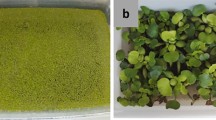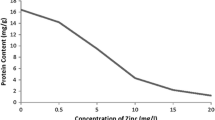Abstract
The capacity of Lemna minor to remediate toxic heavy metals from wastewater is reasonably well documented. In view of the pivotal role of this species in the environmental clean-up, here we evaluated the bioaccumulation potential of L. minor for cadmium (Cd), lead (Pb), and nickel (Ni) through a controlled experiment. L. minor tolerated the metals Cd, Ni, and Pb up to 0.5, 5, and 8 mg/L, respectively, and beyond these concentrations the toxicity symptoms appeared. Bio-concentration factor varied at different concentrations of heavy metals tested. Overall, L. minor showed good phytoremediation potential for all the three tested heavy metals (Cd, Ni, and Pb), though in relative terms it was more effective in extracting Ni and Cd, as compared to Pb, both in single and mixed concentrations. In view of the growing pollution in Kashmir Himalayan aquatic habitats the phytoremediation by invasive species such as L. minor promises to be one of the best choices than other native plants for cleaning up of polluted soils/water because of its fast growth rate, high abundance, easy handling, and wide distribution in Kashmir Himalayan aquatic ecosystems.



Similar content being viewed by others
References
Ahmad SS, Reshi ZA, Shah MA, Rashid I, Ara R, Andrabi SM (2014) Phytoremediation potential of Phragmites australis in Hokersar wetland—a Ramsar site of Kashmir Himalaya. Int J Phytoremediat 16(12):1183–1191
Ahmad SS, Reshi ZA, Shah MA, Rashid I, Ara R, Andrabi SM (2016) Heavy metal accumulation in the leaves of Potamogeton natans and Ceratophyllum demersum in a Himalayan RAMSAR site: management implications. Wetl Ecol Manag 24(4):469–475
Aisien FA, Faleye O, Aisien ET (2010) Phytoremediation of heavy metals in aqueous solutions. Leonardo J Sci 17(4):37–46
Amahmid O, Asmama S, Bouhoum K (2002) Urban wastewater treatment in stabilization ponds: occurrence and removal of pathogens. Urban Water 4(3):255–262
An YJ, Kim YM, Kwon TI, Jeong SW (2004) Combined effects of copper, cadmium, and lead upon Cucumis sativus growth and bioaccumulation. Sci Total Environ 326:85–93
Appenroth KJ, Krech K, Keresztes A, Fischer W, Koloczek H (2010) Effects of nickel on the chloroplasts of the duckweeds Spirodela polyrhiza and Lemna minor and their possible use in biomonitoring and phytoremediation. Chemosphere 78(3):216–223
Bhat SA, Pandit AK (2014) Surface water quality assessment of Wular Lake, a Ramsar site in Kashmir Himalaya, using discriminant analysis and WQI. J Ecosyst. https://doi.org/10.1155/2014/724728
Cardwell AJ, Hawker DW, Greenway M (2002) Metal accumulation in aquatic macrophytes from southeast Queensland, Australia. Chemosphere 48:653–663
Censi PA, Spoto SE, Saiano FI, Sprovieri M, Mazzola S, Nardone G, Di Geronimo SI, Punturo R, Ottonello D (2006) Heavy metals in coastal water systems. A case study from the northwestern Gulf of Thailand. Chemosphere 64(7):1167–1176
Chaudhuri D, Majumder A, Misra AK, Bandyopadhyay K (2014) Cadmium Removal by Lemna minor and Spirodela polyrhiza. Int J Phytoremediat 16(11):1119–1132
Cheng JJ, Bergmann BA, Classen JJ, Stomp AM, Howard JW (2002) Nutrient recovery from swine lagoon water by Spirodela punctata. Bioresour Technol 81:81–85
Fergusson JE (1990) The heavy elements: chemistry, environmental impact adn health effects\Jack E. Fergusson (No. 628.53 F4.)
Gaur A, Adholeya A (2004) Prospects of arbuscular mycorrhizal fungi in phytoremediation of heavy metal contaminated soils. Curr Sci 86:528–534
Goswami C, Majumder A (2015) Potential of Lemna minor in Ni and Cr removal from aqueous solution. Pollution 1(4):373–385
Gounden D, Kisten K, Moodley R, Shaik S, Jonnalagadda SB (2016) Impact of spiked concentrations of Cd, Pb, As and Zn in growth medium on elemental uptake of Nasturtium officinale (watercress). J Environ Sci Heal B 51(1):1–7. https://doi.org/10.1080/03601234.2015.1080477
Häder DP, Banaszak AT, Villafañe VE, Narvarte MA, González RA, Helbling EW (2020) Anthropogenic pollution of aquatic ecosystems: emerging problems with global implications. Sci Total Environ 13:65–86
Hemachandra CK, Pathiratne A (2015) Assessing toxicity of copper, cadmium and chromium levels relevant to discharge limits of industrial effluents into inland surface waters using common onion, Allium cepa bioassay. Bull Environ Contam Toxicol 94:199–203
Kabata-Pendias A (2011) Trace elements in soils and plant. CRC Press, Boca Raton, p 403
Kara YEŞIM, Basaran D, Kara I, Zeytunluoglu A, Genç HASAN (2003) Bioaccumulation of nickel by aquatic macrophyta Lemna minor (Duckweed). Int J Agric Biol 5(3):281–283
Khellaf N, Zerdaoui M (2009) Growth response of the duckweed Lemna minor to heavy metal pollution Iran. J Environ Health Sci Eng 6:161–166
Kiss I, Kovats N, Szalay T (2003) Evaluation of some alternative guidelines for risk assessment of various habitats. Toxicol Lett 411:140–141
Magdaleno A, Vélez CG, Wenzel MT, Tell G (2014) Effects of cadmium, copper and zinc on growth of four isolated algae from a highly polluted Argentina River. Bull Environ Contam Toxicol 92:202–207
Mohan BS, Hosetti BB (1999) Aquatic plants for toxicity assessment. Environ Res 81:259–274
Nies DH (1999) Microbial heavy-metal resistance. Appl Microbiol Biot 51(6):730–750
OECD (2002) Guidelines for the testing of chemicals, Lemna sp. growth inhibition test draft guideline, vol 221. OECD, Paris
Peralta-Videa JR, Gardea-Torresdey JL, Gomez E, Tiermann KJ, Parson JG, Carrillo G (2002) Effect of mixed cadmium, copper, nickel and zinc at different pH upon alfafa growth and heavy metal uptake. Environ Pollut 119:291–301
Peralta-Videa JR, Lopez ML, Narayan M, Saupe G, Gardea-Torresdey J (2009) The biochemistry of environmental heavy metal uptake by plants: implications for the food chain. Int J Biochem Cell Biol 41(8–9):1665–1677
Prasad MNV (ed) (2013) Heavy metal stress in plants: from biomolecules to ecosystems. Springer Science & Business Media, Berlin
Pratas J, Favas PJC, Paulo C, Rodrigues N, Prasad MNV (2012) Uranium accumulation by aquatic plants from uranium-contaminated water in Central Portugal. Int J Phytoremediat 14:221–234
Proulx G, Dubé J, Cloutier G (2019) Socio-economic issues and benefits: the creation of Pingualuit National Park, Nunavik, Quebec (Canada). Téoros, Revue de Recherche en Tourisme. https://doi.org/10.7202/1065649ar
Rai PK (2009) Heavy metal phytoremediation from aquatic ecosystems with special reference to macrophytes. Crit Rev Env Sci Technol 39:697–753.
Saleem M, Jeelani G (2016) Anthropogenic induced evolution of chemical quality of water in Dal Lake, Srinagar
Sarma H (2011) Metal hyperaccumulation in plants: a review focusing on phytoremediation technology. J Environ Sci Technol 4:118–138
Tofighy MA, Mohammadi T (2011) Adsorption of divalent heavy metal ions from water using carbon nanotube sheets. J Hazard Mater 185(1):140–147
Üçüncü E, Tunca E, Fikirdeşici Ş, Özkan AD, Altındağ A (2013) Phytoremediation of Cu, Cr and Pb mixtures by Lemna minor. Bull Environ Contam Toxicol 91(5):600–604
Uqab B, Mudasir S, Sheikh AQ, Nazir R (2016) Bioremediation: a management tool. J Bioremediat Biodegrad 7:331
Uysal Y, Taner F (2009) Effect of pH, temperature, and lead concentration on the bioremoval of lead from water using Lemna minor. Int J Phytoremediat 11:591–608
Verma R, Suthar S (2015) Lead and cadmium removal from water using duckweed–Lemna gibba L.: impact of pH and initial metal load. Alex Eng J 54(4):1297–1304
Vujević M, Vidaković-Cifrek Ž, Tkalec M, Tomić M, Regula I (2000) Calcium chloride and calcium bromide aqueous solutions of technical and analytical grade in Lemna bioassay. Chemosphere 41(10):1535–1542
Wani GA, Shah MA, Reshi ZA, Atangana AR, Khasa DP (2014) cpDNA microsatellite markers for Lemna minor (Araceae): phylogeographic implications. Appl Plant Sci 2(7):14. https://doi.org/10.3732/apps.1300099
Wani RA, Ganai BA, Shah MA, Uqab B (2017) Heavy metal uptake potential of aquatic plants through phytoremediation technique—a review. J Bioremediat Biodegrad 8:404
Xue Y, Wang JQ, Huang J, Li FY, Wang M (2018) The response of duckweed (Lemna minor L.) roots to Cd and its chemical forms. J Chem. https://doi.org/10.1155/2018/7274020
Zayed A, Gowthaman S, Terry N (1998) Phytoaccumulation of trace elements by wetland plants: I. Duckweed. J Environ Qual 27:715–721
Zouainia S, Djebar MR, Sbartai H, Cherait A, Khene L, Kahli H, Berrebbah H (2016) Toxicological impact assessement of cadmium on aquatic macrophyte: Elodea canadensis. Studia Universitatis “Vasile Goldiş”. Seria Ştiinţele Vieţii 26:375–380
Acknowledgements
The financial support provided by the University Grants Commission under its CPEPA programme on Himalayan Biodiversity to MAS is gratefully acknowledged. The financial support by DST-SERB, Govt. of India under the National Post-Doctoral Fellowship (PDF/20l8/001689) to GAW is also acknowledged.
Author information
Authors and Affiliations
Corresponding authors
Additional information
Publisher's Note
Springer Nature remains neutral with regard to jurisdictional claims in published maps and institutional affiliations.
Rights and permissions
About this article
Cite this article
Khan, M.A., Wani, G.A., Majid, H. et al. Differential Bioaccumulation of Select Heavy Metals from Wastewater by Lemna minor. Bull Environ Contam Toxicol 105, 777–783 (2020). https://doi.org/10.1007/s00128-020-03016-3
Received:
Accepted:
Published:
Issue Date:
DOI: https://doi.org/10.1007/s00128-020-03016-3




